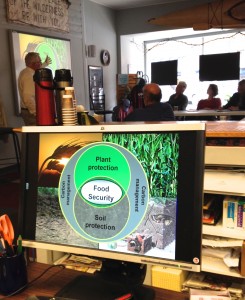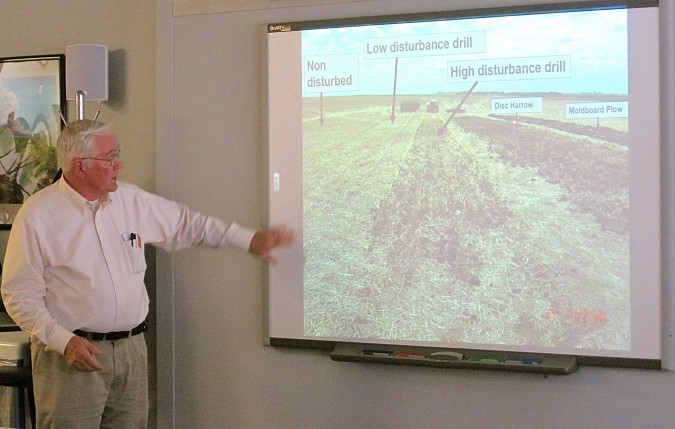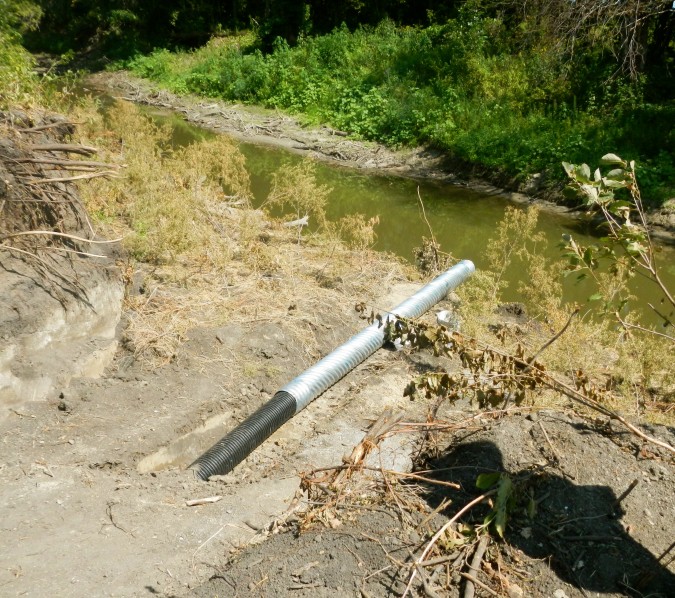Carbon 101—Presented by Dr. Don Reicosky, retired USDA-ARS Soil Scientist
CURE hosted a presentation by Don Reicosky, a retired USDA-ARS soil scientist still actively educating people worldwide about his research on CO2 emissions, tillage practices in agriculture, and soil organic matter. The event was intended for our staff and for the staff of a few other organizations to help increase our soil literacy. And why would the staff of a watershed and climate organization worry about dirt? Because “dirt” is arguably the single most important integrating (and understudied) factor that influences the world’s environment.
THE BASICS
Here’re the basics of what Dr. Reicosky has proven: more soil disturbance in agricultural soils—that’s tillage—leads to the loss of soil organic matter and the off-gassing of CO2 into the atmosphere. Frighteningly, in the 24 hours after an acre of farmland has been tilled with a moldboard plow, the soil releases 1,420 lbs of CO2.
Burning a gallon of gasoline releases about 19.64 lbs of CO2.
Take a deep breath, and when you’re ready, we can go over that again.
TILLAGE AND CO2
At the end of every year, plant detritus and crop residue are left in the field after harvest. Some of it, such as cornstalks and leaves, are above ground. Roots are left below ground. All of this dead organic matter has the element carbon bound up in its molecular structure. If the field is left untilled, these dead plants are slowly incorporated into the soil and add to the “soil organic matter,” the stuff that was once living that gets incorporated into the soil. This, in turn, leads to better soil structure. This is what would normally happen in a prairie ecosystem where grasses and flowers die back to the ground every winter and are left  largely undisturbed until spring, when new green growth shoots up through the dead stuff. This is the process by which the amazing agricultural soils of the Midwest were made.
largely undisturbed until spring, when new green growth shoots up through the dead stuff. This is the process by which the amazing agricultural soils of the Midwest were made.
On the other hand, if fields are tilled after harvest, one really important ingredient is added: oxygen. Oxygen from the air is mixed into the soil, and the soil bacteria go haywire because they, like most consumers and detrivores, “breath” oxygen. They break down the crop residue, combining this extra oxygen with the carbon in the plant matter to “exhale” CO2. The process is not unusual—it’s the same respiration you and I use when we breathe. Nor is it unnatural; bacteria are naturally occurring and necessary components of soil. Even untilled agricultural fields off-gas CO2. Dr. Reicosky’s control plots of untilled fields released about 64 lbs of CO2 per acre in a 24-hour period.
However, 64 lbs is very different from the 1,420 lbs released using conventional tillage practices. And while practicing conservation tillage is better than using a moldboard plow, strip-tilling with a subsoil shank still releases 591 lbs of CO2 within 24 hours after tillage. So, this is the thing, guys: addressing the way we treat “dirt” will be imperative as we address greenhouse gas emissions and the changing climate. And tillage practices alone can affect the amount of CO2 released by agricultural soils by 2,200%.
TILLAGE AND WATER
Here’s another funny thing to consider. Remember how I said that increasing soil organic matter improves soil structure? This is where water comes in. More soil organic matter and better soil structure mean that fields can infiltrate and retain water better. So when we have those big rain events, which will become even more common with a changing climate, agricultural fields will be able to absorb more water before it rushes into our rivers, dragging eroded sediment and nutrients with it. Furthermore, the soil will be able to hold onto water, meaning that when we have more droughts and dry spells, farmers will have to irrigate less, dragging less water out of fossil aquifers.
So, as we move forward as individuals, activists, farmers, scientists, and eaters, in a world that seems to be constantly shifting under our own feet, we must pay a little more attention to that stuff that is under our feet: the soil that sustains and regulates life regardless of where you live and how you make your living.
By Ariel Herrod, CURE Program Assistant


